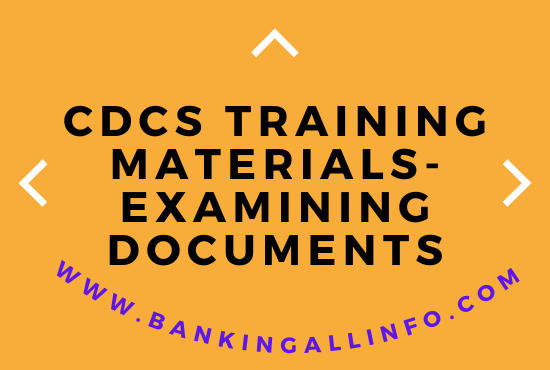CDCS Training materials-Examining documents
Introduction
To develop an understanding of what is considered to represent international standard banking practice in the examination of documents, the ICC Banking Commission published the ISBP, first in 2003 (ISBP 645), then in an updated form in 2007 (ISBP 681), and in a revised form in 2013 (ISBP 745), to explain how the practices articulated in the UCP are to be applied by documentary credit practitioners.
This chapter details the role of the document examiner in the examination of documents. The principles are the same whether the document examiner is working for a nominated, confirming or issuing bank.

13.2 Preliminary tasks
The examination tasks that a document examiner performs will reflect the requirements of his or her role specific to the designation of his or her bank in the documentary credit transaction. In performing the examination, the document examiner should consider the following.
13.2.1 Recording
With regards to individual documents received (including copies), a document examiner should ensure that the documents are as indicated on the covering schedule or letter – that is, in terms of both type and number of originals or copies.
In terms of date and time of receipt, a document examiner should ensure that both have been recorded clearly on the schedule, letter or compliments slip and on internal bank systems.
13.2.2 The schedule or letter enclosing the documents
A presentation of documents is usually accompanied by:
◆◆ a document schedule issued by a bank based overseas or locally; ◆◆ a covering letter from the presenter, usually the beneficiary; or
◆◆ a compliments slip or unidentified slip of paper attached to the documents.
A document examiner usually has little difficulty with schedules issued by banks.
If the presenter has no customer relationship with the bank, and is not a name known to the document examiner, there may be internal guidelines that need to be followed in the case of a covering letter from that presenter.
With regard to the use of a compliments slip or unidentified slip of paper, a document examiner may need to consider how an effective line of communication can be established with the presenter. Internal guidelines will need to be followed.
13.2.3 The availability of the documentary credit
A document examiner must ascertain that the documentary credit number is correct, that the credit is available with the bank for presentation, honour or negotiation (appropriate when the bank is not the issuing bank), and that:
◆◆ the documentary credit has not expired; ◆◆ the amount available is sufficient; ◆◆ previous drawings, if any, appear to be correctly recorded; ◆◆ the documentary credit is available for the goods and prices covered by the presentation; and ◆◆ all amendments are identified and recorded correctly.
In the case of a presentation for which the documentary credit has been advised through another bank, a document examiner must make inquiries with that bank to ensure that all amendments have been presented.
13.2.4 Settlement or payment instructions
A document examiner must ascertain whether the covering schedule, letter, compliments slip or unidentified slip of paper has given clear instructions regarding:
◆◆ settlement – that is, where payment should be sent and how; ◆◆ whether settlement has already been made as a result of an earlier reimbursement claim; ◆◆ charges being claimed by a presenting bank, if any; and ◆◆ advice of payment – that is, how this should be sent.
13.2.5 Discrepancies noted by the presenter
A document examiner should look to see whether the presenter has noted any discrepancies. Where discrepancies are noted, the document examiner is still required to make its own determination of whether or not the documents comply. Additional comments (such as that the discrepancies have been agreed between the applicant and the beneficiary) should be disregarded unless the issuing bank has already forwarded approval of such discrepancies.
13.2.6 Reviewing the documentary credit
Prior to commencing the examination of the documents, a document examiner should read the documentary credit and any amendments thereto, to become familiar with its terms and conditions.
13.2.7 The characteristics of the documentary credit and payment terms
A document examiner should ascertain whether the documentary credit is available at the counters of his or her bank and whether it is available by:
◆◆ sight payment; ◆◆ deferred payment; ◆◆ sight negotiation; ◆◆ usance negotiation; or ◆◆ acceptance.
He or she should also assess whether it is:
◆◆ a transferable credit; ◆◆ subject to a back-to-back arrangement; ◆◆ a revolving credit; ◆◆ a standby letter of credit; or ◆◆ (rarely) a revocable credit.
Once the documents are found to be compliant, a document examiner must compare the presenter’s settlement request with the documentary credit terms in order to determine whether it can be complied with.
In respect of transferable, back-to-back arrangement, revolving, standby or revocable documentary credit types, a document examiner should check any internal operational guidelines and the relevant files to ascertain whether the bank can comply with the requested settlement terms.

CDCS Training materials-Examining documents
